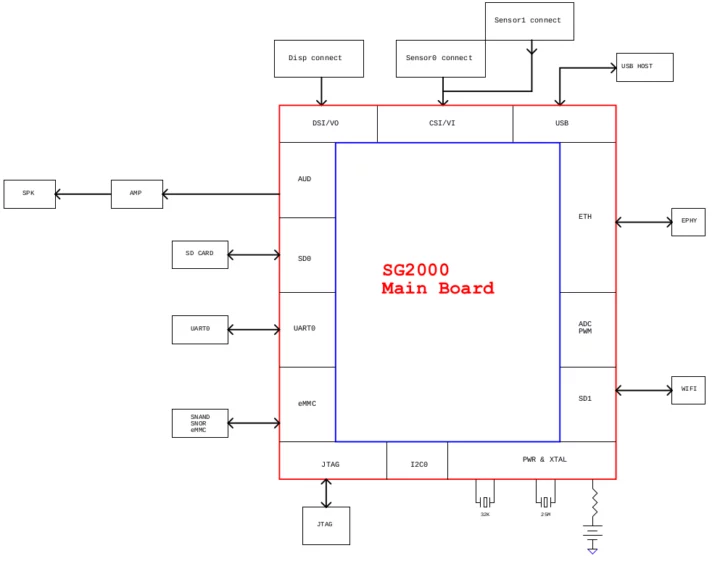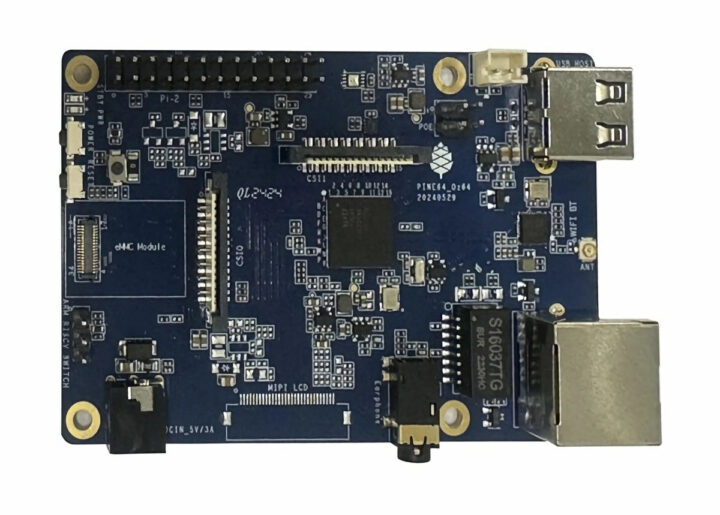Pine64 Oz64 is an upcoming credit card-sized SBC based on the SOPHGO SG2000 RISC-V+Arm(+8051) processor that currently runs NuTTX RTOS, and a Debian Linux image is also in the works.
With a name likely inspired by the earlier Pine64 Ox RISC-V SBC, the Oz64 is a more powerful embedded board with 512 MB of DRAM integrated into the SG2000, a microSD card, an eMMC flash module connector, Ethernet port, WiFi 6 and Bluetooth 5.2, a USB 2.0 Type-A host port, and a 26-pin GPIO header.
Pine64 Oz64 specifications:
- SoC – SOPHGO SG2000
- Main core – 1 GHz 64-bit RISC-V C906 or Arm Cortex-A53 core (selectable)
- Minor core – 700 MHz 64-bit RISC-V C906 core
- Low-power core – 25 to 300 MHz 8051 MCU core with 8KB SRAM
- NPU – 0.5 TOPS INT8, supports BF16
- Integrated 512MB DDR3 (SiP)
- Storage
- MicroSD card slot
- eMMC flash module connector
- Display – Optional 2-lane MIPI DSI connector
- Camera Interfaces – 2x 2-lane MIPI CSI connectors
- Audio
- 3.5mm audio jack
- Built-in microphone
- Networking
- 100Mbps Ethernet RJ45 jack with optional PoE support via expansion board
- 2.4 GHz WiFi 6 and Bluetooth 5.2 via AIC8800DC chip; external antenna connector
- USB – 1x USB 2.0 Type-A port
- Expansion – 26-pin GPIO header with ADC, PWM, I2C, UART, SPI, JTAG, etc…
- Misc – Power, Reset, and Update buttons; 3-pin Arm/RISC-V switch; ATECC608A secure element; 2-pin RTC connector
- Power Supply – 5V/2A via 3.5/1.35mm DC jack
- Dimensions – 85 x 56 mm

Lup Yuen Lee has already released an image based on NuttX real-time operating systems, and the wiki page also lists “SDKs” for Fishwaldo SOPHGO SG200x Debian images already used by other boards, and the SOPHGO NPU TDL SDK to make use of the 0.5 TOPS AI accelerator
It’s not the first board based on SG2000/SG2002 SoC, and we previously covered the Duo S, Duo 256M, and LicheeRV Nano with much smaller form factors. The Pine64 Oz SBC is not available yet, and I only discovered it through a post on X, but based on the feature set, I’d expect it to cost about $15 plus shipping [Update: I’ve just been told it will sell for $12].

Jean-Luc started CNX Software in 2010 as a part-time endeavor, before quitting his job as a software engineering manager, and starting to write daily news, and reviews full time later in 2011.
Support CNX Software! Donate via cryptocurrencies, become a Patron on Patreon, or purchase goods on Amazon or Aliexpress





